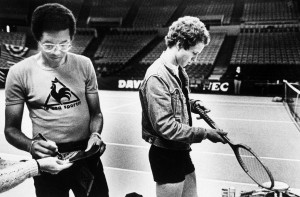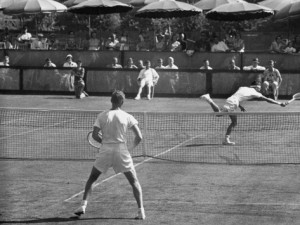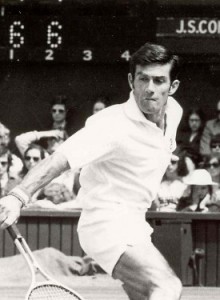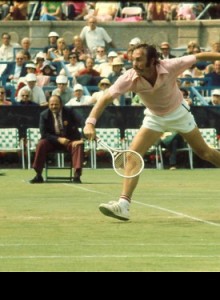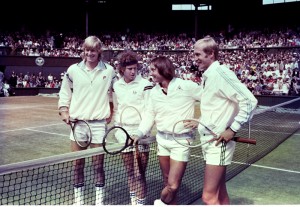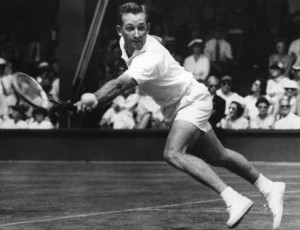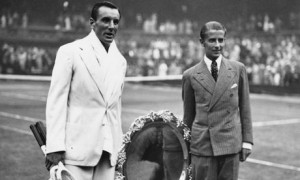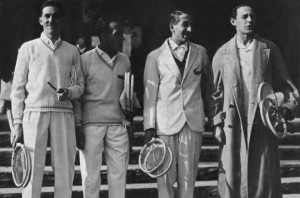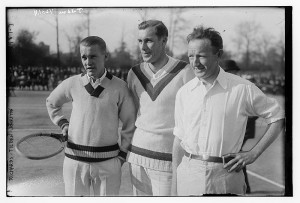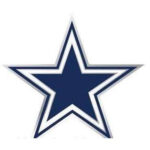The Best Tennis Teams in Davis Cup History.
The Davis Cup competition has been in existence since the start of the 20th century. Today, it is a function of the ITF (International Tennis Federation), but its beginnings were not nearly so formal.
It began as a challenge between the United States and Great Britain to determine who had the best tennis players—the concept dreamed up by some Harvard tennis players.
One of the Harvard fellows bought the silver cup awarded annually—Dwight Davis. Therefore, the name of the tournament evolved from International Lawn Tennis Challenge to the Davis Cup after the man whose trophy was awarded to team winners.
The challenge gradually expanded to add France, Belgium, Austria and Australia in 1905. By 1920, the number of teams participating had increased to over 20 and, by 1969, to over 50.
By now, the Davis Cup competition includes 123 nations who participated in 2012. In 2007, 137 countries were represented—a far cry from the two nations who began the series.
The United States has won the trophy the most with 32 wins. Australia has won it 28 times, with Great Britain and France each winning nine times. Sweden brought home the cup seven times.
Early on, it was easier to repeat as champion because prior to 1972, if a team won the Davis Cup in the previous year, the following year, the team just had to play one tie—the final, while the “challengers” had to fight it out in zonal competitions throughout the year.
The evolution of the format has been very interesting and necessary with over 100 teams participating every year.
Throughout its long history, the Davis Cup has fielded some remarkable teams that dominated the competition for over a year—often several years.
Here are the best teams in Davis Cup History.
12. Germany 1988-1989: Boris Becker, Carl-Uwe Steeb and Eric Jelen
 Boris Becker should not just be remembered for his play at Wimbledon in the 1980s, he should also be recalled for playing in Davis Cup competition for Germany during his career—helping them to win two consecutive titles in the late 1980s.
Boris Becker should not just be remembered for his play at Wimbledon in the 1980s, he should also be recalled for playing in Davis Cup competition for Germany during his career—helping them to win two consecutive titles in the late 1980s.
In December of 1988, playing in Sweden, the German team of Carl-Uwe Steeb, Boris Becker and Eric Jean, who teamed with Becker in doubles, defeated Sweden 4-1 to win their Davis Cup final.
The Swedes had Mats Wilander and Stefan Edberg in singles, as well as Edberg and Anders Jarryd playing doubles. But this day, the Germans dominated.
In 1989, the Germans again defeated the Swedes 3-2, playing on indoor carpet in West Germany.
The Germans won back-to-back Davis Cup ties from 1988-1989, winning seven of the 10 rubbers. Germany would win another tie in 1993, which gives them three so far in Davis Cup history.
11. Australia 1950-1952: Frank Sedgman, Ken McGregor, Mervyn Rose/John Bromwich
Almost without interruption, Australia won the Davis Cup competition from 1950-1967, with the United States coming through to win in 1954, 1958 and 1963.
From 1950 through 1952, the team of Frank Sedgman and Ken McGregor, along with Mervyn Rose and John Bromwich—who played in doubles competition—won three consecutive Davis Cup ties.
In 1950, the Australian team defeated the United States 4-1, with only McGregor dropping the fifth rubber in his match with American Tom Brown.
The following year, in 1951, Australia defeated the United States 3-2, with Mervyn Rose holding down a slot in singles and Sedgman and McGregor teaming for doubles.
In 1952, the Sedgman and McGregor team defeated the United States team 4-1, losing only the fifth rubber when McGregor fell to American Vic Seixas in four sets.
This team of Australians won three consecutive Davis Cups, each time defeating the USA. It was just the beginning for the Aussies, who would go on to reign in Davis Cup for almost two decades.
10. US 1968-1970: Arthur Ashe, Clark Graber, Cliff Richey and Stan Smith/Bob Lutz
In 1968, the new Open Era in tennis began, ending the old system of amateurs and pros. Once again, all professionals could play in all events, including Davis Cup competition.
In the midst of this transition, the United States defeated Australia 4-1 in 1968 with Arthur Ashe and Clark Graebner, along with the doubles team of Stan Smith and Bob Lutz.
This came at a time when Australia totally dominated the Davis Cup competitions. It marked the beginning of a new era for the United States and other teams who would rise to the top once the Aussies were toppled.
In 1969, the team from the U.S.A. met the team from Romania, winning 5-0 over Ilie Nastase and Ion Tiriac. Stan Smith and Arthur Ashe plus Smith and Bob Lutz in doubles swept the Romanians.
In 1970, the team from the United States defeated the team from West Germany, 5-0. This time, it was Arthur Ashe and Cliff Richey playing singles and Smith and Lutz standing strong in the doubles match.
For three years, this team won 14 of 15 rubbers, defeating Australia, Romania and West Germany.
It was a great comeback for the United States.
9. Australia 1953-1956: Lew Hoad, Ken Rosewall and Rex Hartwig
In 1953, another set of new faces appeared in the line up for the Australian Davis Cup team.
Lew Hoad and Ken Rosewall took over play during the singles rubbers, while Rex Hartwig added some doubles play. The Aussies trumped the United States 3-2 in 1953.
But in 1954, the United States would unexpectedly strike back, winning that tie 3-2.
In 1955, however, the Aussies began to dominate action, winning their tie over the United States 5-0 with Rosewall and Hoad leading the way.
In 1956, the team of Hoad and Rosewall did it all, winning singles and doubles to capture the cup once again, 5-0.
This team from Australia won three out of four ties against the United States, allowing the opponents to win only five rubbers out of 20 during the four-year span.
8. Spain 2008-2012: Rafael Nadal, David Ferrer, Feliciano Lopez/Ferando Verdasco
The team from Spain is the newest to dominate in Davis Cup competition. Since they are still active, the Spaniards have an excellent chance to advance in this ranking.
In 2008, the team from Spain beat the team from Argentina, 3-1. Rafael Nadal, unable to participate, had to watch as teammates David Ferrer and Feliciano Lopez won in singles, with Lopez and Fernando Verdasco teaming in the doubles competition.
Then, in 2009, with Nadal back and ready to play, Spain swept the Czech Republic, 5-0, using the talents of Nadal and Ferrer in singles plus Lopez and Verdasco in doubles.
The Spaniards won every set except the first two in doubles play. Lopez and Verdasco had to capture the last three to win the rubber.
In 2010, the Spaniards were unexpectedly upset by France in the second round.
In 2011, however, Spain once again faced Argentina in the Davis Cup final held in Seville, Spain. Nadal and Ferrer played the singles matches, with Lopez and Verdasco playing doubles. They defeated the team of Juan Martin del Potro and Juan Monaco in singles and David Nalbandian and Eduardo Schwank in doubles.
In 2011, Spain won the tie 3-1.
From 2008-2011, Spain won three out of four Davis Cup ties. In the process, the Spaniards took 11 of 13 rubbers.
Spain has advanced to another final in 2012, where they will face the Czech Republic for the second time in four years. The results are yet to be seen.
7. Sweden 1984-87: Mats Wilander, Stefan Edberg, Anders Jarryd/Henrik Sundstrom
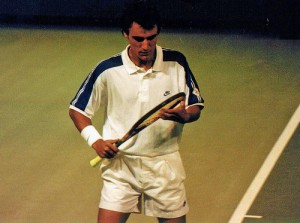 In 1984, the Swedes won the Davis Cup 4-1, defeating the team from the United States which included John McEnroe and Jimmy Connors.
In 1984, the Swedes won the Davis Cup 4-1, defeating the team from the United States which included John McEnroe and Jimmy Connors.
Mats Wilander and Henrik Sundstrom won in singles, while the doubles team of Stefan Edberg and Anders Jarryd upset McEnroe and Peter Fleming.
In 1985, the Swedes once again held on to defeat the West German team led by Boris Becker 3-2. Wilander and Edberg played singles, while Joakim Nystrom teamed with Wilander in doubles.
In 1986, however, the Swedes lost to Australia 2-3 with a team led by Pat Cash and Paul McNamee.
But in 1987, the Swedes won again, defeating India 5-0. Mats Wilander teamed with Anders Jarryd to win in singles and in doubles, sweeping India who won only one set during the entire tie.
The talented Swedes won the Davis Cup three out of four years from 1984 through 1987, winning 14 of 20 rubbers. They made all four finals.
In fact, the Swedes appeared in five consecutive Davis Cup finals starting in 1983, when they lost to the Australians.
It total Sweden would win seven Davis Cup championships, appearing in 12 ties overall.
6. Australia 1964-1967: Fred Stolle, Roy Emerson, John Newcombe and Tony Roche
After the United States won the Davis Cup challenge in 1963, Australia came back in 1964 to capture another title.
This time, the Australian team was led by Fred Stolle and Roy Emerson playing singles and doubles. The duo won 3-2.
In 1965, however, the Aussies added John Newcombe and Tony Roche to play doubles with Stolle and Emerson playing singles—winning 4-1 over the Spaniards of Manuela Santana and Juan Gisbert.
In 1966, Stolle, Emerson, Newcombe and Roche defeated a team from India 4-1 to win their third consecutive title.
Finally, in 1967, the team of Roy Emerson, John Newcombe and Tony Roche would win their final Davis Cup tie over the Spanish team of Manuel Santana ad Manuel Orantes 4-1.
In all, this quartet won 15 of 20 rubbers in four years.
Australia would win again for a year or two, but they would never dominate Davis Cup ties like they did earlier in the 1950s and 1960s.
5. U.S.A 1978-1982: John McEnroe, Peter Fleming, and Stan Smith/Bob Lutz
In 1978, the United States fielded a team filled with some very young and some very seasoned players. John McEnroe began his illustrious career in Davis Cup competition in this winning effort. He was joined by Brian Gottfried in singles, while Bob Lutz and Stan Smith competed in doubles. They won 4-1.
The following year, in 1979, with Vitas Gerulaitis replacing Brian Gottfried, the United States defeated the team from Italy 5-0.
Losing in the Americas Inter-Zonal Final to Argentina, the U.S. did not make the 1980 Davis Cup Final.
But they were back in 1981, winning over Argentina 3-1 with McEnroe joined by Roscoe Tanner in singles. The soon-to-be-famous McEnroe and Peter Fleming doubles team replaced Smith and Lutz. The U.S.A. downed Guillermo Vilas and Jose Luis Clerc.
In 1982, the United States faced France in the Davis Cup final, winning 4-1. This time, McEnroe’s singles partner was Gene Mayer. They all combined to defeat Yannick Noah and Henri Leconte.
This team anchored by a young John McEnroe won the Davis Cup in four of five years from 1978 to 1982. During the matches, the U.S. team won 16 of 19 rubbers in Davis Cup finals.
4. Australia 1959-1962: Rod Laver, Neale Fraser and Roy Emerson
Once again, the Australians were dealt a new hand filled with more winners.
In 1959, the players were Rod Laver, Neale Fraser and Roy Emerson, who defeated the defending champions from the United States, 3-2, playing on the grass courts of the West Side Tennis Club.
As strange as it may seem, Rod Laver lost both his singles rubbers in this 1959 tie.
In 1960, the Aussie team of Fraser and Laver defeated the Italians 4-1 to win their second consecutive Davis Cup title. This time, it was Neale Fraser who lost the fifth rubber to Nicola Pietrangeli.
Facing the Italians once more in 1961, the Australian team of Fraser, Laver and Emerson won decisively 5-0, with Roy Emerson taking over the Davis Cup singles matches and Fraser settling into doubles.
Finally, in 1962, Australia met surprise finalist Mexico in Brisbane for the finals of the Davis Cup. Australians Laver, Fraser and Emerson won 5-0 over the Mexicans.
This team won four consecutive Davis Cup ties from 1959-1962, allowing the opposition to win only three rubbers out of 20.
3. Britain: Fred Perry, Bunny Austin, Patrick Hughes, Harry Lee/Raymond Tuckey
Fred Perry and Bunny Austin brought down the great French team led by Henri Cochet in 1933, with the Brits winning their tie, 3-2.
Soon, they would assume their place at the top of the Davis Cup roll call for the next four years.
In 1934, the Brits, led by Bunny Austin and Fred Perry, defeated the U.S. team of Frank Shields and Sidney Woods 4-1, losing only their third rubber as the doubles team of Patrick Hughes and Raymond Tuckey went down to defeat.
The following year, in 1935, the same Brit team headed by Austin and Perry won over the United States 5-0, their best effort so far. This time, the U.S. team had added Don Budge, who replaced Sidney Woods.
Finally, in 1936, Perry and Austin defeated the team from Australia who had made their way to the final by defeating Germany.
Great Britain won that tie 3-2, with Bunny Austin defeating Jack Crawford, and Fred Perry defeating Adrian Quist. But the Australian doubles team won and Quist won the fourth rubber over Austin.
This would mark the end of Great Britain’s four-year run as Davis Cup champions from 1933 to 1936.
2. France 1927-1932: Henri Cochet, Jean Borotra, Jacques Brugnon and Rene Lacoste
After finally overcoming the U.S. team headed by Big Bill Tilden and Little Bill Johnston, France began a run of their own. The French dominated Davis Cup competition from 1927-1932—for six years.
In 1927, Rene Lacoste managed to beat both Johnston and Tilden in singles competition. Tilden won his singles rubber against Henri Cochet, and the doubles match teamed with Frank Hunter. Still, France came out on top, 3-2.
The following year, in 1928, France won 4-1 over the United States, who played with Bill Tilden but without Bill Johnston.
The only losing rubber France suffered was when Henri Lacoste lost to Big Bill Tilden in the opener.
This tournament was the first Davis Cup challenge held on the grounds of Stade Roland Garros—built by the French, in part, to take down the dominant Bill Tilden and the United States. Instead of grass, the Davis Cup was now played on clay on what would become the greatest clay court in the world.
In 1929, France again faced the United States and Bill Tilden—but this time, it was tougher with the Frenchmen prevailing 3-2. France lost their doubles rubber and one to Bill Tilden, who defeated Jean Borotra in the fourth rubber. Nonetheless, it marked their third consecutive Davis Cup victory.
Even though Bill Tilden would win the opening rubber in 1930, defeating Jean Borotra, the United States would fall 4-1 to France, giving them their fourth consecutive win in Davis Cup competition.
This would mark the end of Bill Tilden’s presence in Davis Cup—11 straight years, never missing once. It would take the U.S. sometime to recapture the magic Bill Tilden gave them.
In 1931, France faced Great Britain and a new dominating team just beginning to find its way into the winner’s circle. Still, France won this tie over Britain 3-2, with Henri Cochet and Jean Borotra leading the charge.
In 1932, France found itself facing the United States in the final, but without Bill Tilden. Instead, the French faced Ellsworth Vines, Wilmer Allison and John Van Ryn, defeating the trio 3-2 to win their sixth consecutive Davis Cup challenge.
1932 would mark the end of the reign of France over Davis Cup competition, as Great Britain took center stage for the next four years.
1. U.S. 1920-1926: Bill Tilden, Bill Johnston and Norris Williams/Vincent Richards
From 1920 through 1926, Bill Tilden alongside Bill Johnston of the United States dominated Davis Cup competition as no other team from any other nation has ever done.
In 1920, the two did not lose a rubber, defeating the team from Australia 5-0—playing both singles and doubles throughout the tie.
In 1921, Japan was the newcomer on the block, upsetting Australia but losing 5-0 to Tilden and Johnston of United States, with Watson Washburn and Norris Williams taking on the doubles duties for the U.S. that year.
For the next three years, the United States faced Australia—defeating them 4-1 in 1922, 4-1 in 1923 and 5-0 in 1924.
Only the doubles team of Tilden and Vincent Richards failed to win their rubber in 1922. In 1923, Bill Johnston lost the second rubber to Australian James Anderson, but the U.S. won the other four.
From 1925-1926, the U.S. defeated France 5-0 and 4-1, respectively. Frenchmen Rene Lacoste and Jean Borotra lost to Tilden and Johnston, 5-0.
In 1926, the same U.S. team defeated France 4-1, with Frenchman Lacoste and Borotra adding teammates Jacques Brugnon and Henri Cochet to play doubles.
This would mark the beginning of the French team that would soon dominate Davis Cup action.
The following year in 1927, the United States would lose after a seven-year reign.
No team in the history of Davis Cup ever played as consistently for so long in finals. The Tilden led team won 32 of 35 rubbers in seven consecutive years—a mark which will be nearly impossible to equal or surpass in the modern era.
